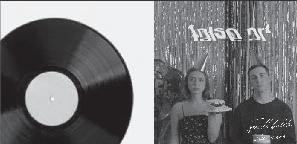
16 minute read
Eastern performs “She Kills Monsters.”
from Newspaper: Fall 2021
by The Voyager
By MAURA SOMERS ‘23 Special to The Voyager
Art. A three letter word to describe the essence of life. Art is used to insinuate a thought or feeling through color, music, or even words. It is used to express feeling and emotion. Underneath a veil in art are all things true and allow for feelings of comfort and peace. Relationships that are formed in life could be viewed as either a masterpiece, or a complete mess. Either way, a relationship is a piece of art created by a bond that is strong enough to withstand obstacles in real life. In a relationship or not, art is depicted as a truth behind a type of entity, either fi gurative or physical, that covers up the meaning or message; whether it be a picture, book, relationship, or music. When art is covered up from a perspective of lies, it cannot hold the truth in what the art is trying to convey. When there is a lack of truth, that feeling becomes what Ben Kessler calls “false art.” A false perception of what you want people to see. The song, “False Art” by Ben Kessler, captures the meaning of what art can be seen as when one is not true with oneself or others. The fi rst time I listened to the song, I was In the passenger seat of my sister’s run down, blue volvo. As I stared out of the window, my eyes scanned the heavy traffi c on the black, icy roads. The winter brought an unsettling feeling of uncomfort and bitter cold. The only positive of my time on the snow covered roads was being on my way home from getting a hot caramel cappuccino from Starbucks, my favorite place to get drinks during the cold of the winter. I was in a dark place deep in my mind, stuck in my own head full of self doubt. I felt numb, empty. I could not fi nd a place to escape my intrusive thoughts. The people I knew and were close to saw I was happy and thought I was fi ne because I said I was, but it was an act. It was false. I was secretly hurting inside and no one knew it. It was not until my sister, Tara, shuffl ed her Spotify playlist and a certain song played throughout the vessel of the car that I awoke from my subconscious strain of thoughts that kept me distracted from reality. The soft strum of the guitar played a soft melody that stopped me dead in my tracks. The low voice of the male singer created a comfort of peace and warmth. Words poured out of the speakers in the car like a trickle of water leaving its pitcher. I immediately asked Tara what the song is simply because of the beauty that lies beneath the tune. “False Art by Ben Kessler,” she replied. I silently listened to the lyrics.
Advertisement
“Waiting for the glass house to come down/ Waiting to hear that crashing sound/ Waiting for the right words to tell you how/ I don't wanna be false art”
The metaphors used in the lyrics tries pointing to a message that is subliminal yet obvious. The singer sings about how a picture perfect relationship is actually a messy and broken one underneath the surface. The metaphor, “waiting for the glass house to come down” symbolizes the structure of their relationship. The infrastructure is built like a house, sturdy yet valuable, but the design is glass. The house is fragile and transparent. When one is able to see inside of a relationship, the heavy truth is revealed
as well as the reveal of a mask behind the pain. The repetition of the word “waiting” used at the beginning of each line can signify the heavy burden weighed on top of the relationship. All that the singer wants is to stop pretending that he is okay when really, he knows his relationship is slowly falling apart and he wants to end this act of love that is not there anymore. Behind closed doors, the love the couple has for each other is not real; they cover it up with smiles and seemingly perfect pictures that are posted on social media as well as faking a love act in front of their friends.
“False Art” by Ben Kessler paints a picture of a strained relationship.
Photo supplied by Walter Bowne
“Pretend we're picture perfect/ When we're breaking beneath the surface/ I don't wanna be false art/ Make love like we deserve it/ To cover up what's hurting”
Underneath the melodic beauty of the song was a pain in Kessler’s voice. He sings of a love that is not meant to be and wants to stop pretending that he is okay. I relate to the lyrics of the song, not because of a relationship but from a view of myself that I hate. Like Kessler, I no longer want to pretend I am picture perfect when I am also breaking beneath the surface. In a way, I thought everyone was hiding a broken piece of themselves behind a facade just because I was. Trying so hard to cover up the hurt people do not see can be frustrating. I wanted to believe that I was not alone in what I was dealing with. Although the song depicted a toxic relationship, I heavily resonated with what the hidden meaning was. The art that comes with a relationship creates beautiful images and happy experiences, but once that art fades into a sea of lies that is hidden behind a veil, it becomes false. False art is not something that is yearned for but it tends to end up as a factor in many people’s lives that affect their relationships with others as well as themselves. When covering up an emotion or damage, things tend to fall apart just so other people do not see what is happening behind closed doors.
“She Kills Monsters” is Eastern’s return to the theater
By NICK VITALE ‘22 Staff Reporter
Grab your character sheets and swords, and get ready for this year’s fall play! Eastern Theater’s latest production will be She Kills Monsters, a 2011 comedy-drama penned by Qui Nguyen. While at surface level the show may seem like nothing more than a love-letter to D&D, it tackles the subjects of loss and teenage sexuality in a refreshingly innovative way. Set in 1995 in the town of Athens, Ohio, the story centers around high school senior Agnes Evans, whose freshman sister, Tilly, tragically passed away in a car accident. A year after her death, Agnes discovers that Tilly’s favorite hobby was playing Dungeons and Dragons. So, in an attempt to learn more about the sister she barely knew, Agnes dives full on into a D&D module which Tilly wrote. Through the help of other D&D players from her school, Agnes is able to complete a quest, while also learning more about her little sister. She Kills Monsters will be Eastern’s fi rst live, indoor production in front of an audience since A Funny Thing Happened on the Way to the Forum way back in November of 2019. Since then, the theatre club recorded and aired a production of It’s a Wonderful Life and mounted a full scale production of Seussical on the football fi eld at McAleer Stadium. Senior Annette Kroes, who plays Agnes, discussed the perks of being back in the Performing Arts Center. “There’s a different, immersive experience when you’re on a stage with a set in a confi ned space, as opposed to being on the football fi eld with all that space around you,” she said. Being back in the theater isn’t the only new aspect that comes with She Kills Monsters, as the show also discusses teen sexuality and the LGBTQ+ community. Over the course of the story, Agnes learns that Tilly was gay and had a crush on her classmate Lilly. In one particular scene, Agnes confronts Tilly in a rather blunt and ignorant way, which was a typical response for a time like 1995, but one that feels out of place today. Dr. Molotsky, director of the production, commented on the show’s LGBTQ+ themes. “It’s common to the students at school now, it’s no big deal. But it was certainly something that wasn’t happening in the 1980s and 1990s at the time. I think it’s great that we have characters on stage that are expressing now rather than the values of 1980 or 1950,” he said. While certainly “out there,” She Kills Monsters represents a new age of theater, where a story taking place in 1995 is now a period piece and D&D nerds are portrayed as superheroes. It’s defi nitely not your typical play, but She Kills Monsters ignites that little part of geek in all of us. While having a laughout-loud script, it manages to create a storyline and characters that the audience can easily connect to. Overall, She Kills Monsters is unlike any show you’ve seen before. As Dr. Molotsky says, it’s expressing now, and doing so in a fun, unique way. Eastern’s production will run from November 18th to November 20th; hope to see you there!
Telling a story about the LGBTQ+ community through the frame of
Dungeons and Dragons, “She Kills Monsters” is a unique production.

By ALANNA STEIN ‘24 Staff Reporter
Most eighteen year olds spend their days sitting at desks, listening to their teacher lecture on and on about information they will forget by lunchtime. They are swamped with homework and extracurriculars on the weekdays but still make time to socialize with friends on weekends. While they stress about what they are wearing to the Friday night football game or— more importantly— their future plans, Emma Raducanu worries about whether to hit a forehand or backhand.
US Open winner Emma Raducanu kisses the US Open Trophy following a 6-4, 6-2 win against Leylah Fernandez.

Photo: Timothy A. Clary, APF Emma Raducanu is an eighteen year old British tennis player who recently won her first Grand Slam in her second ever appearance in a professional tour-level event. Before the competition, Raducanu was ranked one hundred and fiftieth in the world, but following the competition, she jumped around one hundred and twenty-seven spots to number twenty-three. Due to her initially low ranking, Raducanu played in and won three qualifying matches before even competing in the tournament’s main draw. Without ever dropping a set, Raducanu hastily made her name known as the first female qualifier to secure a spot in a grand slam final, let alone win one. She effortlessly defied expectations of the public, making history with almost every shot. In the first all-teenage championship since 1999, Raducanu seized the early lead against Leylah Fernandez in the first set. Through unforgettable baseline placement and notable drop shots, Raducanu took control of the game and swiftly won the first set 6-4. Raducanu’s mental toughness proved to be an immense asset to her game in the second set. Up 5-2, Raducanu slid on the blue-dyed concrete, creating a gash in her knee. A five-minute medical timeout left Raducanu a chance to analyze her past points and develop new strategies to implement against the fierce Fernandez. Upon resuming the game, tension was high, but Raducanu’s momentum was low. Fernandez took the opportunity to win one more game as the score now sat 5-3 with Raducanu leading. In the final game of the match, Raducanu mustered up a powerful ace on her third break point to claim the title as the winner of the 2021 US Open Women’s Singles bracket. Raducanu won the trophy with grace and persistence while displaying aggressiveness at the net and consistency at the baseline. Although Raducanu may be unfamiliar with sitting at desks for six hours under bright fluorescent lights, she nevertheless knows how to manage her time as she still received her high school degree. Emma Raducanu teaches students everywhere that they can pursue their dreams while focusing on their education as well.
United States Grand Prix highlights F1’s growth in America
By JOSEPH LOVERDI ‘22 Sports Editor
Netflix is a beautiful thing. The concept of being able to stream any show at any given time is one brilliant invention. Formula One must be thanking its lucky stars that Drive to Survive has been so popular on the streaming service, especially during quarantine. And the one country that gorged itself on Drive to Survive more than anyone else was the good ol’ US of A. Over 50 million people have watched the show according to McLaren CEO Zak Brown, and the show’s had a monumental impact in bringing in new, mostly American, fans to the sport, this article’s author included. It was an immediate smash, even without Mercedes and Ferrari (the title contenders in 2018) participating in season one. Quarantine left people looking for a show to watch, and Drive to Survive filled that void for many people. I watched all three seasons, which cover 2018-2020, covering storylines from the Haas/Rich Energy sponsorship debacle to Red Bull’s search for a consistent second driver following Daniel Ricciardo’s 2019 move to Renault, and found it to be incredibly riveting, as did many others. I think we all knew Drive to Survive would have an immense impact on the sport, but we didn’t really see that until the United States Grand Prix returned to the F1 calendar in 2021 (it couldn’t be held in 2020 because of COVID). With the sport’s explosion in popularity in the States, expectations were high. 400,000 people made the trip to the Circuit of the Americas throughout the race weekend with 140,000 on race day, making it the most attended race weekend in Formula One history and cementing the United States Grand Prix as a calendar keystone (it had been taken off the calendar in 2008 following declining attendance at the Indianapolis Motor Speedway, especially after a farcical race in 2005 where only 6 cars started the race in the midst of a tyre war between Michelin and Bridgestone). Millions more tuned in on ABC to watch a thrilling race where Max Verstappen continued to increase his lead, now 12 points up on Lewis Hamilton with 5 races left in the season. Verstappen was able to hold off a charging Hamilton at the very end, finishing just over a second ahead of his title rival, as Red Bull’s decision to pit Verstappen early for an aggressive two-stop worked wonders. Hamilton had beaten Verstappen off the line and was leading until he first pit; Verstappen would lead every other lap when he wasn’t in the pit or behind Hamilton on older tyres. The battle for fifth was also intriguing, as McLaren’s Daniel Ricciardo was able to defend from Ferrari’s Carlos Sainz, who then wore his tyres out and lost out on sixth to Valtteri Bottas, who’d started 9th due to an engine change after qualifying fourth. Yuki Tsunoda’s horrid run of
Over 400,000 attendees, the most in Formula One his-
tory, watched the thrilling United States Grand Prix. form ended with a strong showing to claim ninth (his first points since Hungary), while Kimi Raikkonen had impressed, fighting his way up to tenth until a spin on the last lap led to Sebastian Vettel, starting from 18th thanks due to a full engine change, claiming his first point since that joke of a race in Belgium. Overall, it’s easy to judge the United States Grand Prix as a rousing success. It proved that Formula One is not only here now, but it’s here to stay and still growing. We haven’t seen it peak, and we probably won’t for a while.

Photo by Formula One Media, Limited
It delivered a thrilling race between title contenders to boot, as Verstappen and Hamilton fought for the lead until the bitter end; the midfield continued to thrill as well, whether it be Ricciardo and Sainz battling throughout the race or Fernando Alonso’s battles with both the Alfa Romeos of Raikkonen and Giovinazzi and the stewards. Formula One looks like it might finally stick in the United States after years of trying, and the 2021 United States Grand Prix showed what it can bring.
Major League Baseball’s Sanction against Substances
By KYLE GOLDSTEIN ‘24 Staff Reporter
With the World Series just ending, as the Atlanta Braves defeated the Houston Astros 4-2, it is imperative to note a new change to the game that was made this season, which will alter the game indefinitely. On June 15th, the MLB officially announced it would be enforcing strict rules on foreign substances beginning on the twenty-first. The new guidelines prohibit all foreign substances of any kind, bar rosin, from being applied to the ball or being within a player’s possession. Regular checks for illegal applications are enforced, usually taking place between innings or during pitcher changes. Players who are caught violating the rules will be ejected from the game and given an immediate ten game suspension. So, why are these changes being made all of a sudden; if pitchers have been using adhesives for over a century, what is the reason they’ve started cracking down on the sticky stuff? A rule has nearly always been present in baseball’s history that foreign appliances aren’t permitted. However, for years, the MLB has been leaving it up to opposing coaches to request umpires to check a pitcher if they are suspicious of foul play. Since many pitchers had been using substances anyway, coaches were reluctant to ask for an inspection of the other team out of fear that their pitcher would be punished as well if they were cheating. Batters were never angered by pitchers using adhesives because they preferred better control of the pitches thrown at them. Pitchers use stick substances to help them have better control of the ball, which is used for the benefit of increasing spin rate, or revolutions of the ball per minute (RPM). Increasing RPM allows the ball to move faster and curve more to the pitcher’s desire. Batters care less whether pitchers use mixtures to help them, such as rosin or sunscreen, because they don’t want to be hit by pitches. However, a new substance that pitchers begun using made other players feel they had
too substantial of an advantage on the mound – Spider Tack. According to its official website, Spider Tack is a “super sticky paste,” and its intensive properties at play became How will MLB’s new substance rules affect pitching the main concern in the seasons to come? Photo: Kyle Ross, Icon Sportswire which caused the MLB to alter the rules entirely, banning nearly all substances and implementing strict precautions and punishments. Pitchers were enraged at the new guidelines, as the MLB was not only banning Spider Tack, but also almost every other lesseffective tool used for sticking. After years without consequence, professional baseball players now have to live with no aid to their throw. Some pitchers have found ways to protest the frequent checks implemented by officials. Max Scherzer of the Washington Nationals removed his belt and persuaded the umpires to feel through his sweaty hair in outrage. Oakland Athletics reliever Sergio Romo even took off his belt and let his pants slide down during checks between innings. No matter how the players feel, it looks as if the new additions to the rules are going to stay for the time being. The most interesting aspect of this situation is how the pitchers that have relied on adhesives through their career will make the transition. However, this will also allow pitchers with even greater raw talent to shine through this opportunity and arise to greatness. In the upcoming seasons, we will witness how the players evolve without substances and see if the MLB will continue to enforce the rule – or allow pitchers to return to their old tricks.




